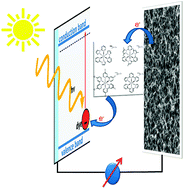A new generation of platinum and iodine free efficient dye-sensitized solar cells†
Abstract
We report a series of cobalt complexes with various polypyridyl ligands, where the oxidation potential is tuned from 0.17 to 0.34 V vs. ferrocene. The highest occupied molecular orbitals (HOMO) of the cobalt complexes were stabilized by adding electron acceptor groups on pyridyl or replacing pyridyl by pyrazole. These complexes are then used as one-electron redox mediators in dye sensitized solar cells (DSSCs) together with polymer based cathode resulting in an excellent performance. The performance of DSSCs using the molecularly engineered cobalt redox shuttle and poly(3,4-alkylthiophenes) based cathode is better than the triiodide/iodide redox shuttle with platinized cathode. The use of high surface area poly(3,4-propylenedioxythiophene) based nanoporous layers allows higher catalytic activity thus minimizing the electrode–electrolyte interface issues.


 Please wait while we load your content...
Please wait while we load your content...